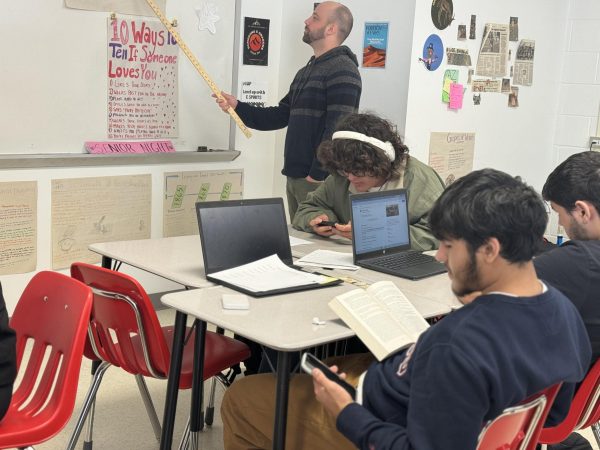Humanitarian crisis extends reach to AHS
90 new ESOL students enrolled at AHS, some coming from refugee camps at the U.S.-Mexican border
Joe Smith (not his real name) was in holding for 15 days after being taken into custody by Border Patrol near the U.S.-Mexican border.
Smith had escaped his home country of El Salvador due to gang violence and increasing drug activity in the area.
He had come to America in search of a better future for himself and his father, who was already here.
After waiting in a shelter for 15 days (Smith could not be turned away because he was not from Mexico or Canada) in the Southwest Sector of the border and after having immigration talk extensively with his father, Smith was sent on a plane here, to his father, in Northern Virginia.
After flying to NOVA, Smith went through the process of getting the correct vaccinations and the correct paperwork filled out for him by the United States Department of Health and Human Services Office of Refugee Resettlement. Smith then enrolled at AHS, in the ESOL program.
“It [ESOL] is helping me [to read] in English,”” Smith said.
Smith is one of over 60,000 unaccompanied minors that have entered the U.S. since last October in what has been described by President Obama as an “urgent humanitarian situation.”
Locally
That number is double what it was in 2012, and triple what it was in 2011, according to a study from the United Nations High Commissioner on Refugees. In total, according to U.S. Customs and Border Protection, the Southwest Border has seen a 77 percent increase to 68,541 people from 38,759 a year ago.
Roughly 2,000 of those children have been enrolled in Northern Virginia schools.
The ORR says there are around 1,775 such children in the three prominent NOVA counties. There are 1,131 in Fairfax County, 417 in Prince William and 227 in Loudoun.
Of the 1,131 students in Fairfax County, 90 of them enrolled at AHS in September. AHS ranks fourth in the number of refugee students enrolled there amongst FCPS schools, behind Herndon HS, Jeb Stuart HS and Falls Church HS.
The introduction of these students into AHS has presented a problem, as with any influx of students that large.
“We planned for 40 at that [the beginning] level[s] this year; we now have 90 students enrolled,”” ESOL Department Chair Leslie Chekin said. “Last year, in all of our beginning levels combined we had a total of about 80 kids. This year we are up to about 140 right now.”
The program has almost doubled in size since last year.
“We’ve actually had to restructure our entire program based on this particular group of students we are taking in,” Chekin said. “We are in the process of creating more beginner level classes. There are five levels in our program, we teach four of them, and in the past we have had one set of classes for beginning level classes. We had around 15 in that group, and this year we have created two additional sections and we have 20 students in each of those sections, so that is like a fourfold increase from what we have had in the past.”
The changes in classes also change the dynamics between both students and each other and students and their teachers.
“In the past, we’ve had a lot of diversity [in our classes]. For example, I’ve had students from Korea, I’ve had students from Peru, I’ve had students from Bolivia, I’ve had students from Pakistan, Afghanistan, Bangladesh. It’s been a mixture,” ESOL teacher Kimberly Sisskind said. “Now I have all primarily Spanish speakers. So when you have about 19 students speaking primarily Spanish, and only one student that speaks Urdu, that makes a big difference when they’re talking to friends or working on an activity together, they’re going to go back to Spanish as opposed to try to practice in English.”
This change has forced students to rely on their developing English skills more than their native language because they can’t always communicate in that language.
“I think the largest problem is the language barrier because little things can have different meaning and there can be miscommunications,” Sisskind said. “Also, if they don’t understand what I’m saying but they listen to the tone of my voice, that makes a big difference. Small things can definitely get blown out of proportion.”
The program’s benefits can be seen through its graduates who move on to take regular English classes at AHS.
“The ESOL program as really nice teachers and they know how to help you,” senior Mariela Bobadilla said. “They are really prepared and they know what you need to learn and how you need to learn to able to speak better, to write better and to read better. The teachers were the ones that really helped us.”
Being in the ESOL program can also pose a number of issues that the students themselves must overcome.
“The biggest challenges were changing from your life in Portugal, your friends, all the people, all the things you’ve done, to a completely different country, when you don’t know anyone, there is a little discrimination,” junior Mario Gutierrez said.
“Sometimes you feel like the ESOL program makes you feel left out. You don’t get the chance to be in a group or something because you don’t understand what everyone is saying and you feel left out,” Bobadilla said.
The Issue
Since October of last year, there has been a drastic increase in the number of unaccompanied minors that have been detained near the U.S.-Mexican Border. According to the U.S. Department of Health and Human Services Office of Refugee Resettlement (ORR), the influx really began in 2011, but has spiked greatly since October 2013.
One of the issues that adds to this situation is the fact that immigrants are not coming from places like Mexico or Canada, where they can just be turned around if caught trying to cross the border. The issue is that roughly 70 percent of the new wave of immigrants are coming from three countries: El Salvador, Guatemala and Honduras.
These immigrants cannot be turned around due to a bipartisan law that President George W. Bush signed in 2008, known as the Trafficking Victims Protection Reauthorization Act. This law grants protection to unaccompanied immigrants who are not from Mexico or Canada. Instead, they become refugees, housed in one of the shelters run by the ORR. In 2013, there were 80 shelters that the refugees stayed in for an average of 45 days.
Resolutions
In order to solve the issues that arise with the large influx of students, many measures are being taken both locally and nationally.
On the national level, President Obama has asked Congress for an additional $1.4 billion to deal with the “situation”. According to the President, this money would go towards creating a new multi-agency taskforce to coordinate the federal response to the influx.
In addition, the U.S. Department of Health and Human Services has been working through their Office of Refugee Resettlement to relocate and connect refugees to their families or sponsors while they await the proceedings.
On the local level, specifically at AHS, there have been measures taken to alleviate some of the stress from the ESOL teachers.
“We have hired 1 new teacher this year. We are hoping that we are going to get more staffing support from the principle but we haven’t had that yet, that is still to come,” Chekin said. “Right now we are desperately in need of another set of classes for this level because we continue to enroll students.”
60,000. The number of refugee students that was projected by the ORR. As this number grows and grows to surpass expectations, it is important to realize that this is fully a humanitarian crisis. With all of these unaccompanied minors at the U.S. border, the American public, as well as the government, now more than ever needs to focus on reaching a bipartisan solution in a timely manner, something that it has struggled at in the past.

Jarod is a senior at Annandale High School and has been with The A-Blast for four years. Aside from being the Co-Editor in Chief, Jarod also participates...










